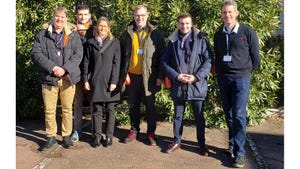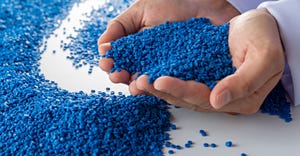Overmolding winner merges design and process
March 1, 2001
What makes a consumer product successful? Using Kodak's high-profile Max Sport camera as an example, the answers might range from function and aesthetic appeal to price and ease of use. Behind these achievements, however, lies another explanation for the ubiquitous camera's success; namely, it exemplifies a product designed in concert with processing needs.
Now in its fourth year of production, the Max Sport relies on a patented, two-part housing overmolded with TPE on a 220-metric-ton, two-shot press at Eastman Kodak Co.'s Precision Plastics Molding facility in Rochester, NY. The housing consists of a clear polystyrene substrate and a specialized compound based on Kraton G, an SEBS elastomer. To marry design requirements with processing realities, Kodak worked closely with its tooling and materials suppliers.
All Together Now
Bill Moucha, manager of Kodak's Precision Plastics Technology Center (next to the molding facility), credits the project's success to this early supplier involvement at the design phase. "We were familiar with two-shot molding," he explains. "Since the mid '80s, we had been designing these types of parts and molding them. But on the complexity scale, the Max Sport ranked as perhaps the second hardest. With any new product, there is a ramp-up schedule. Dates never move, no matter what hangups you have. This project went smoothly, and I attribute it to our close work with suppliers."
One of the goals that made this project difficult was its projected volume, estimated at "fairly high" (Kodak declines to specify an actual number). The production system itself was designed as a just-in-time workcell, making molding accuracy a critical factor. "Precisely timing the two shots was essential to meeting the volume demands," adds Moucha.
On the design and materials side, the process was driven by Kodak's industrial design group. The camera needed a rugged soft material for overmolding that would also provide a nonslip grip, impact resistance, and waterproofing. With GLS, supplier of the customized TPE, Kodak technicians molded and tested different durometer materials before settling on the correct grade.
"We needed a balance of properties," Moucha says, "including UV and suntan lotion resistance, along with a hardness of 28 Shore A." GLS also worked with Kodak to optimize mold texture, release angles, and colorant. The customized Dynaflex material, a TPE compound based on Kraton G, included unique flow properties adjusted to meet the camera's requirements.
Quiet Complexity
From a design standpoint, the Max Sport was a bit more complex than other one-time-use cameras molded at Kodak. It's molded in two halves and then snapfit together. "Take it apart and look at the covers and you still can't figure out how the part was molded," Moucha says. "We were able to mold in a gasket with the Kraton G material that helps seal the rear of camera after it is assembled." Kodak received a patent for this design, in which the TPE material must flow around the camera perimeter.
The moldmaker, Foboha GmbH (Germany), was also closely involved with the camera's development. According to Moucha, the process of building the tools took longer than expected based on an internal tool build time of 10 to 12 weeks for a single-shot, medium complexity tool. Now that they have been up and running for several years, however, he says, "The added time was worth the wait, because the tools have been extremely reliable."
You May Also Like


